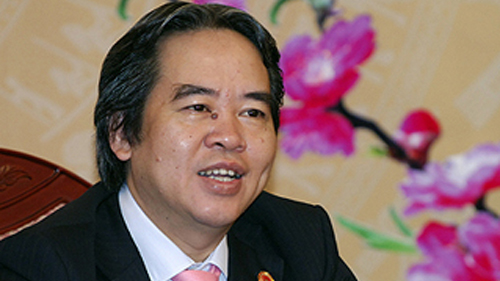Exchange rates to follow market rules
In a recent interview granted to the Government’s portal, Binh made an in-depth analysis of market trends in 2013 and the central bank’s management policy. Following are excerpts from the interview.

Reporter: Could you talk about the SBV’s plan to stabilise exchange rates in 2013?
Governor: The difficulties confronting the global economy are forecast to continue in 2013, largely because of the international trade market’s slow recovery. Vietnam is also part of the story though the country’s monetary policy prioritises inflation control, macroeconomic stabilisation, and economic growth.
The State bank will intensify its efforts to keep exchange rates in alignment with the market law of supply and demand. Other factors taken into account include interest rates, inflation rates, and the balance of payments. We aim to maintain the value of Vietnam Dong (VND) over the long term to increase foreign currency reserves and prevent the dollarisation of the national economy. Therefore, credit organisations play an important role in channeling financial sources in a way that strengthens capacity to meet the economy’s legal demand for foreign currency.
The SBV’s monetary policy will be more cautious and flexible with the aim of keeping inflation under control and stabilising goods prices, the VND’s value, and the foreign currency market as well.
The central bank will also focus on managing the domestic gold market and promoting exchanging gold into VND to invest in production.
Reporter:The lending interest rate is expected to stand at 10 percent/year. What is the SBV’s roadmap for interest rate adjustment this year?
Governor: The SBV has already applied a lending rate of 10 percent/year since the beginning of 2012, with the intention of reducing the rate by 1 percent/year on a quarterly basis. However, the inflation rate is currently declining and there is reason for optimism regarding the foreign currency market. The State bank is therefore able to exceed expectations with interest rate cuts in the near future.
With the inflation rate at 7–8 percent in 2012, the central bank reduced the lending interest rate by 5 percent to 9–15 percent/year, targeting different groups of borrowers.
It then lowered the rate by an additional one percent/year when inflation dropped to 6.81 at the end of last year.
In 2013, the bank will use monetary policy and fiscal policy in concert to limit inflation, boost economic growth, and stabilise the macroeconomy. Bank interest rates will be adjusted in line with inflation rates and foreign currency market fluctuations.
If 2013’s inflation rate is kept at around 6 percent as expected, the SBV will consider downward adjustments in lending interest rates while continuing to monitor potential inflationary forces.
Reporter: The banking sector is implementing a restructuring process to deal with bad debts and increase operational efficiency. What are the SBV’s measures to accelerate the ongoing process in 2013?
Governor: The central bank is drawing up a detailed plan for the restructuring of credit organisations in 2013. The focus will be on devising bank safety regulations that correspond with the actual financial situations in Vietnam and internationally, legislating bank share purchases and M&A deals, and monitoring the implementation of restructuring schemes approved in 2012.
The SBV has yet to receive any official proposal regarding the merger of Sacombank and Eximbank.
The State bank pays the attention to bad debt settlement warrants and provides advice to help commercial banks increase their liquidity and risk management capacity.
Bad debt ratios in the last months of 2012 decreased remarkably compared to the beginning of the year. In the future, credit organisations will concentrate on reevaluating their bad debts, identifying the current financial statuses of their clients, and ensuring their information on market fluctuations is kept up to date.
Reporter: Could you elaborate on the overall picture for the whole banking sector in 2013? What do you expect for the sector in the new year?
Governor: The banking sector can expect ongoing challenges in 2013. Realising the SBV’s goals of stabilising the macroeconomy, facilitating business operations, and managing gold and foreign currency markets is no easy task. Successfully restructuring credit organisations to international standards by 2015 will also be another uphill task.
The central bank will work closely with relevant ministries and agencies to implement monetary and fiscal policies that effectively manage prices and ease difficulties for businesses—especially those beset by the real estate sector’s inefficient operations.
The domestic gold market will operate more efficiently, delivering benefits to customers and mobilising capital sources for the national economy.
I believe the SBV’s monetary policy in 2013 will help curb inflation rates, remove obstacles to businesses, boost economic growth, and ensure social welfare.
Reporter: Thank you.
What the stars mean:
★ Poor ★ ★ Promising ★★★ Good ★★★★ Very good ★★★★★ Exceptional
 Tag:
Tag:
Related Contents
Latest News
More News
- Tax sector wraps up 2025 and sets priorities for next year (December 25, 2025 | 14:00)
- A tipping point for digital and hybrid wealth management in Vietnam (December 23, 2025 | 13:33)
- $250 million deal targets women-owned SMEs, sustainable agriculture (December 22, 2025 | 17:40)
- Stock market posts resilient 2025 performance (December 19, 2025 | 18:17)
- Citi Vietnam receives 2025 AmCham CSR recognition (December 19, 2025 | 16:35)
- As global green supply chain reshapes, will Vietnam be left behind? (December 19, 2025 | 08:00)
- Banks gear up for massive capital increases (December 18, 2025 | 17:04)
- Securing capital and efficiency for Vietnam’s 2026-2030 growth ambitions (December 17, 2025 | 10:00)
- Energy sector in need of blended finance mechanisms (December 17, 2025 | 09:00)
- Vietnam still has room to mobilise capital for sustainable growth (December 17, 2025 | 08:57)






















 Mobile Version
Mobile Version